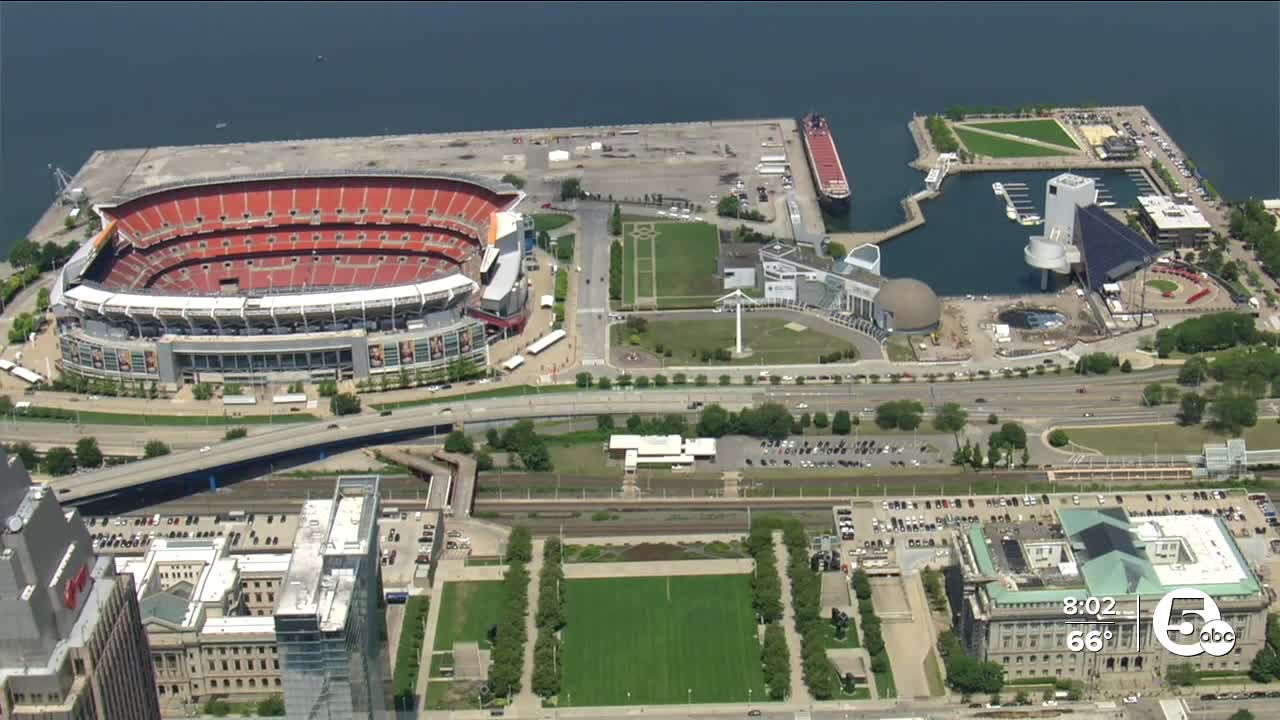CLEVELAND — The final version of Cleveland's new lakefront plan puts a premium on public space — places to play, relax and touch the water, with the Downtown skyline at your back.
But that vision hinges on much less sexy stuff: Roughly $460 million in infrastructure and transportation work, including a land bridge that will link the center of Downtown to the barren property north of Cleveland Browns Stadium.
On Monday, the city will release the final master plan, along with updated drawings of the land bridge and a reimagined Cleveland Memorial Shoreway, during a public forum Downtown. Officials shared the images in advance with News 5 – and explained the path they're taking to turn a long-discussed dream of lakefront development into a reality.

The public meeting will run from 4 to 7 p.m. on Mall C, the grassy area just west of Cleveland City Hall, off Lakeside Avenue. Mayor Justin Bibb is scheduled to speak. There will be a panel discussion, short presentations and opportunities to share your opinions.

"We're eager to hear from people, and we want people to walk away feeling like they understand. They're excited. And feel like they've been heard – and listened to," said Joyce Pan Huang, the city's planning director.

Cleveland has been talking about the future of the Downtown lakefront for at least a century. But public officials and civic leaders believe there's a unique opportunity to make something happen now by tapping into a huge pool of federal money for infrastructure.
"I understand people's skepticism – their healthy skepticism of another lakefront plan," said Scott Skinner, executive director of the North Coast Waterfront Development Corp., a new nonprofit organization devoted to delivering on the lakefront plan.

But, he added, "We're in a place where we are very close to executing … Where we're seeking funding opportunities. Where we're finalizing master plans. Where we're talking about infrastructure needs and actually getting ready to move forward."
'Things that are accessible'
If the city wins key federal grants and loans, construction on the land bridge might start in 2027 or 2028. That project also would involve converting a stretch of the Shoreway into a boulevard, with a speed limit of 35 mph as drivers pass through Downtown.
And the federal money would help pay for a new public transit station, a hybrid bus-and-rail hub that would replace the old Amtrak station next to the Shoreway.
The land bridge — a curved, elevated park for pedestrians – would stretch from Mall C over the Shoreway and touch down just north of Browns Stadium.
RELATED: Ohio lawmakers propose $20 million for Cleveland land bridge connecting downtown to Lake Erie
"The bridge is really the first step in unlocking the lakefront," Huang said.
The connector would position roughly 25 acres of city-owned land for development. Today, that property is a series of pitted parking lots used for Browns games, major stadium events – and not much else.
"Now, if you are at City Hall or Mall C and you want to get to the lake, it's about a 20-minute walk," said Keshia Chambers, the assistant director of the mayor's office of capital projects. "This will make that walk approximately five minutes … maybe 10 because you're going to be enjoying all of the features on the land bridge."

At the end of that walk, planners envision a nature-themed playground. A sun deck. Porch-like shelters where people can sit and people-watch. A fishing pier. Athletic courts. And a protected beach, where it will be possible to dip your toes in or wade — but you won't be able to swim out into the busy harbor.
The master plan, drawn up by a New York-based firm called Field Operations, shows a handful of new buildings, including a food hall, a hotel and apartments. But 60% of the area will be public space. That's a direct response to feedback from residents.
"A large percentage of people said, 'Hey, we really want things that are accessible,'" Huang said. "That might not require money to go see at the lakefront."
'Our lakefront is there 365 days a year'
Of course, there's one big unanswered question: What happens to the stadium?
The Browns are weighing whether to stay Downtown or move to Brook Park, to a site near Cleveland Hopkins International Airport. Their lease on the city-owned stadium near the water expires at the end of the 2028 football season, so they're facing a tight timeline to make a decision.
Renovating the existing stadium could cost $1 billion, a price the team is looking to split with taxpayers. The city's lakefront master plan shows that a ramp off the land bridge would lead fans into the remade stadium, into the bleacher section called the Dawg Pound.
Building a new, domed stadium in Brook Park could cost $2.4 billion, with half of the money coming from public sources. That project would sit on a 176-acre site, where there's room for additional private development, like retail, offices, dining and entertainment.
Cleveland officials say they're still working to keep the team Downtown. On Thursday, they announced a $461 million financing proposal to entice the Browns to stay.
RELATED: City of Cleveland pitches $461 million deal to keep Browns stadium on lakefront
"We very much want the Browns to remain in Cleveland and on the lakefront," said Jeff Epstein, the city's chief of integrated development. "We think they're a great asset to continue building our lakefront plans around; however, if they choose to leave, we believe that the need to implement these lakefront plans is just as great."
That includes the land bridge, an idea that Browns owners Jimmy and Dee Haslam have been championing since 2021. At that time, the Haslams released their own proposal for lakefront development, with a heavier emphasis on new buildings and parking garages.
"The design, all along, of the land bridge has been to take you to the lakefront, not to take you to the stadium," Epstein said. "The stadium is used 10 to 15 times a year. Our lakefront is there 365 days a year."
'Cleveland has punched below its weight'
The city recently applied for a $260 million federal grant to help finance the bridge, the Shoreway overhaul and the new transit station. That money would come from a highly competitive U.S. Department of Transportation program focused on large, tricky projects.
And lakefront access is extremely challenging.
There's a 60-foot drop between the northern edge of Mall C and the lakefront.
In between them, the Shoreway carries almost 11 million vehicles a year. Hundreds of trains crisscross the neighboring freight and passenger railroad tracks.
"Historically, Cleveland has punched below its weight in terms of accessing large-scale federal funds for really complicated projects like this," said Skinner, who has a background in development. "And that's something that we're trying to turn around."

Under the proposal, the Shoreway would drop down at West 3rd Street to become a tree-lined boulevard, with traffic lights at West 3rd and Erieside Avenue.

The plans call for a total reimagining of the intersection at East 9th Street, near the Rock and Roll Hall of Fame and the Great Lakes Science Center. Drawings show sidewalks, more crosswalks and a protected bicycle and pedestrian path.

A new exit from the boulevard at East 18th Street would give drivers the option to hop off and drive south into Downtown instead of hugging the lakeshore. The Port of Cleveland would get its own dedicated access road, keeping trucks off the reimagined Shoreway.
Chambers, who is focused on the technical side of the project, said the changes to the roads will slow traffic and make the area safer for people walking or riding bicycles and scooters. But she doesn't expect the design to cause big traffic snarls.
"Running the models, it is just a small amount of delay time," she said.
'For recreation, for healing, for wellness'
Skinner is working on ideas for short-term projects and events that will liven up the land north of the stadium now, while the city waits to hear back on big funding requests.
He's not ready to talk about specifics yet. But he has one overarching goal: "To get folks down here on a more regular basis. To get folks experiencing joy on the waterfront."
RELATED: We need action.' New Cleveland lakefront nonprofit picks developer to lead the way
The city and its partners could hear back on their large federal grant application in the next two months. Meanwhile, they're pursuing other grants and chasing a low-interest federal loan that could cover 20% of the infrastructure costs. And they're preparing to seek more detailed engineering drawings for the road, bridge and transit projects.
State lawmakers recently awarded $20 million to the land bridge.
Additional money for the infrastructure work could come from a new tax-increment financing overlay district that spans Downtown and parts of close-lying neighborhoods.
That district is an economic development tool that will allow the city to pay for public infrastructure today by borrowing against future property-tax growth. It won't raise property taxes. Instead, it will capture new tax revenues from Downtown development and use them to pay for things like better streets, sidewalks, parks and recreation facilities.
Part of that money will go toward projects across the city. But officials are reserving most of the revenues for the lakefront, the riverfront behind Tower City and other Downtown projects as Cleveland strives to change its relationship with the water and become a more appealing place to live, work and invest.
"This may be Downtown, but it's for the city as a whole. This is an effort that is going to bring, I think, some opportunities for recreation, for healing, for wellness," Chambers said.
"Yes, we know it's very infrastructure heavy," she said of the city's strategy. "But it's heavy in other ways, because we know that the city has been disconnected from the lake for so long. And we want to make sure that we reconnect that."







